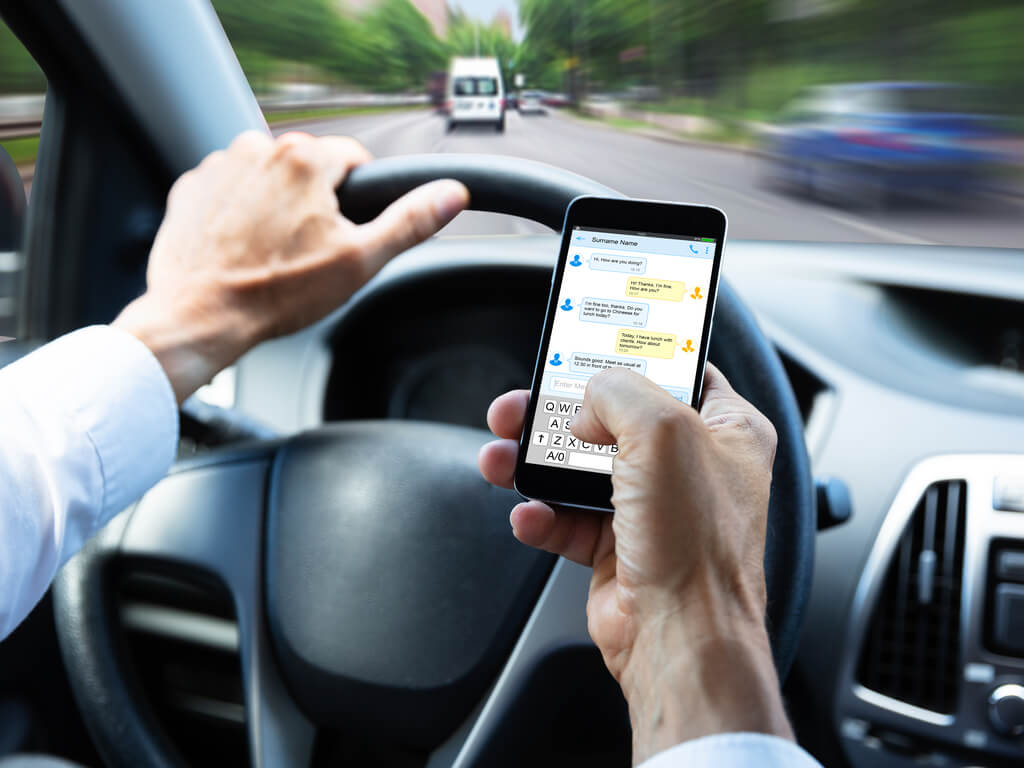Free Consultation

What Are All the Types of Distracted Driving?
Distracted driving is one of the most common causes of car accidents in the United States. It’s so common that an average of nine people are killed every day from crashes caused by distracted drivers. Those who are only injured in these crashes still number over 420,000, with many requiring extensive hospital visits, large medical bills, and time spent not working.
But what is considered distracted driving? It’s defined as when someone is driving and they allow themselves to become distracted and take their attention off the road. This is vague and leaves a lot open for interpretation.
For example, you could say that drinking alcohol could be considered distracted driving because you purposely made yourself unable to focus on the road. But, under the law, drunk driving is not considered distracted driving. Another example to consider is if you naturally look at a roadway advertisement and rear-end someone in front of you. You didn’t choose to look away, but you were distracted and the law expects you to know not to look at advertisements legally allowed to distract you.
Everyone should understand what exactly is distracted driving in case they are the victim of someone who drives while distracted.
What Are All the Types of Distractions?
To understand what is considered distracted driving, let’s start by explaining what is considered a distraction on the road. This helps separate distracted driving from other traffic violations, such as driving under the influence.
There are four types of distractions to consider when driving:
- Visual distraction: This is when you take your eyes off the road. While looking at a sign may not be a conscious choice, it is still the driver’s responsibility to not get overly distracted by them. Looking away for a brief moment is not considered a distraction.
- Manual distraction: This is when you take your hands off the steering wheel. Even if you have one hand on the steering wheel, if you use one hand while the other hand does anything other than sit, that’s a manual distraction.
- Auditory distraction: This is when a loud noise is affecting your ability to concentrate on the road. In this instance, the fault can be with something other than the distracted driver, depending on what the distracting noise was.
- Cognitive distraction: This is when you take your mind off driving, but not when you are under the influence. This is strictly when you’re not paying attention due to your willpower, not due to the influence of an outside substance.
Knowing what is considered a distraction under U.S. law, we can then detail the most common examples of what is considered distracted driving.
What is Considered Distracted Driving?
Some examples of distracted driving can fall under multiple types of distractions. For instance, eating can be a visual distraction as you get your food, a manual distraction as you eat and drive at the same time, and a cognitive as you put energy into eating.
Distracted driving due to visual distractions includes:
- Looking at billboards
- Looking at other cars
- Rubbernecking, or looking in on an accident as you pass by
- Looking at another person on the street or in your passenger seat
- Looking at your phone or GPS
Distracted driving due to manual distractions includes:
- Eating food or drinking
- Texting
- Searching items that fell underneath your seat
Auditory and cognitive distractions have the most crossover of any of the four types of distractions. Distracted driving due to auditory and/or cognitive distractions includes:
- Listening to music at loud volumes while driving
- Talking on the phone
- Talking with passengers
- Screaming children in the back seat
- Text notifications or ringtones
- Being emotionally upset while driving
What to Do if You’re in a Distracted Driving Accident?
Whether you were the distracted driver or hit by one, the first thing you should do is make sure you, your passengers, and the other driver are alright. Contact emergency services and once everyone is safe and/or you’ve done everything you can, photograph the scene of the accident.
It’s important to have as much evidence as possible to defend yourself both to your insurance, and in court if you need to file a lawsuit or defend yourself. If you and/or a loved one are the victims of a distracted driver, you shouldn’t have to pay for the car repairs and medical bills that follow.
Don’t fight alone, contact the injury attorneys at Scartelli and Olszewski, P.C. We’re small enough to care and big enough to fight for you.
Peter Paul Olszewski, Jr., a shareholder and managing partner at Scartelli Olszewski, P.C., brings 37 years of litigation experience. He is a renowned trial lawyer in Pennsylvania, specializing in medical malpractice, personal injury, and criminal defense. Peter's notable achievements include securing multi-million-dollar verdicts and serving as District Attorney and Judge. He is committed to community involvement and is actively engaged in various legal associations.
Linked In - https://www.linkedin.com/in/peter-paul-olszewski-jr-11115b1a/

